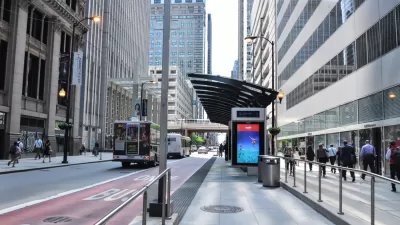The plan being proposed for a new bus-rapid-transit (BRT) line operating along busy Ashland Avenue would limit left turns and see the removal of a traffic lane. Will it survive "political vetting by Mayor Rahm Emanuel’s office"?
Chip Mitchell reports on the controversy surrounding the ambitious plan for 4.5 miles of Ashland Avenue being backed by the Chicago Transit Authority, the Chicago Department of Transportation and the Chicago Department of Housing and Economic Development. "The design favored by the Chicago planners resembles the boldest of four BRT alternatives the city presented last fall for the corridor. Each direction of Ashland would have one regular traffic lane and a bus-only lane near the middle of the avenue. In each direction, the design leaves a parking lane next to the sidewalk, city officials say. There would be no bike lanes." The route would incorporate other features including: station platforms, advanced payment, and prioritized traffic lights.
"Some Chicago business owners along the route are already voicing worries about BRT, particularly about eliminating non-bus lanes. 'The idea of cutting the traffic capacity in half has caused a lot of questions for businesses and property owners,' said Roger Romanelli, executive director of the Randolph/Fulton Market Association."
"City officials respond that their BRT plan would slow automobiles just slightly and speed up buses dramatically," notes Mitchell. "The city says the new bus service would be up to 80 percent faster than today’s service."
"Asked whether Emanuel was behind the plan and whether he would stick behind it if business owners revolted, his office had little to say. 'All of this is still under review,' Tom Alexander, a mayoral spokesman, wrote in an email message to WBEZ."
FULL STORY: Chicago planners push boldest bus-rapid-transit option

Trump Administration Could Effectively End Housing Voucher Program
Federal officials are eyeing major cuts to the Section 8 program that helps millions of low-income households pay rent.

Planetizen Federal Action Tracker
A weekly monitor of how Trump’s orders and actions are impacting planners and planning in America.

Ken Jennings Launches Transit Web Series
The Jeopardy champ wants you to ride public transit.

Rebuilding Smarter: How LA County Is Guiding Fire-Ravaged Communities Toward Resilience
Los Angeles County is leading a coordinated effort to help fire-impacted communities rebuild with resilience by providing recovery resources, promoting fire-wise design, and aligning reconstruction with broader sustainability and climate goals.

When Borders Blur: Regional Collaboration in Action
As regional challenges outgrow city boundaries, “When Borders Blur” explores how cross-jurisdictional collaboration can drive smarter, more resilient urban planning, sharing real-world lessons from thriving partnerships across North America.

Philadelphia Is Expanding its Network of Roundabouts
Roundabouts are widely shown to decrease traffic speed, reduce congestion, and improve efficiency.
Urban Design for Planners 1: Software Tools
This six-course series explores essential urban design concepts using open source software and equips planners with the tools they need to participate fully in the urban design process.
Planning for Universal Design
Learn the tools for implementing Universal Design in planning regulations.
Ada County Highway District
Clanton & Associates, Inc.
Jessamine County Fiscal Court
Institute for Housing and Urban Development Studies (IHS)
City of Grandview
Harvard GSD Executive Education
Toledo-Lucas County Plan Commissions
Salt Lake City
NYU Wagner Graduate School of Public Service



























